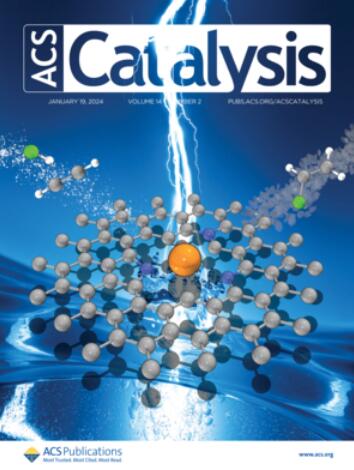Aqualigase: A Star Enzyme for One-Step Peptide Bond Dehydration Condensation in a Nature Aqueous Phase
IF 11.3
1区 化学
Q1 CHEMISTRY, PHYSICAL
引用次数: 0
Abstract
One-step amine–carboxyl dehydration condensation in cells (100% aqueous phase) is the most efficient and sustainable natural method for peptide and protein synthesis. However, most peptide ligases need modifications of substrates at the C- or N-terminal. To create this ligase, we engineered a “water-shielded” reaction chamber in protease subtilisin-P225A through precise polarization calculation using our self-developed PPC force field, thereby converting the hydrolysis reaction to a ligation reaction. We marked the first success and achieved 12 monomutants at first-round mutagenesis. The combined mutant P225A/N62L/S63L/Y217L/N218F with the highest activity was named Aqualigase. The X-ray structural and HDX-MS analysis confirmed a 20%–50% reduction in proton exchange and 50% elimination of water from the active site, demonstrating the success of the “water-shielding effect”. With Aqualigase/N158E, we successfully achieved the one-step synthesis of teriparatide, addressing the long-standing challenges in long-chain peptide or protein ligation. Notably, Aqualigase was also able to catalyze dealcoholizing ligation, transamidation, and esterification reactions. Its suitability for the length, size, and even the N- or C-terminal sequence composition of peptides or protein provides a huge scope for in situ protein conjunction in cells and peptide synthesis in industry.

水合酶:在自然水相中一步肽键脱水缩合的明星酶
一步胺羧基脱水缩合(100%水相)是合成肽和蛋白质的最有效和可持续的自然方法。然而,大多数肽连接酶需要在C端或n端修饰底物。为了构建这种连接酶,我们在蛋白酶subtilisin-P225A中设计了一个“水屏蔽”的反应室,利用我们自行开发的PPC力场进行精确的极化计算,从而将水解反应转化为连接反应。我们标志着第一次成功,在第一轮诱变中获得了12个单突变体。活性最高的组合突变体P225A/N62L/S63L/Y217L/N218F被命名为Aqualigase。x射线结构和HDX-MS分析证实,质子交换减少了20%-50%,活性部位消除了50%的水,证明了“水屏蔽效应”的成功。利用Aqualigase/N158E,我们成功地一步合成了特立帕肽,解决了长链肽或蛋白连接的长期挑战。值得注意的是,水合酶还能催化脱醇结扎、转酰胺和酯化反应。它对多肽或蛋白质的长度、大小,甚至N端或c端序列组成的适用性,为细胞中的原位蛋白质连接和工业上的肽合成提供了巨大的空间。
本文章由计算机程序翻译,如有差异,请以英文原文为准。
求助全文
约1分钟内获得全文
求助全文
来源期刊

ACS Catalysis
CHEMISTRY, PHYSICAL-
CiteScore
20.80
自引率
6.20%
发文量
1253
审稿时长
1.5 months
期刊介绍:
ACS Catalysis is an esteemed journal that publishes original research in the fields of heterogeneous catalysis, molecular catalysis, and biocatalysis. It offers broad coverage across diverse areas such as life sciences, organometallics and synthesis, photochemistry and electrochemistry, drug discovery and synthesis, materials science, environmental protection, polymer discovery and synthesis, and energy and fuels.
The scope of the journal is to showcase innovative work in various aspects of catalysis. This includes new reactions and novel synthetic approaches utilizing known catalysts, the discovery or modification of new catalysts, elucidation of catalytic mechanisms through cutting-edge investigations, practical enhancements of existing processes, as well as conceptual advances in the field. Contributions to ACS Catalysis can encompass both experimental and theoretical research focused on catalytic molecules, macromolecules, and materials that exhibit catalytic turnover.
 求助内容:
求助内容: 应助结果提醒方式:
应助结果提醒方式:


